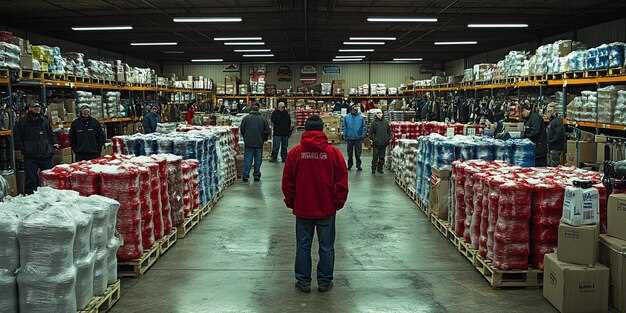Consolidate your footprint now by trimming to strategic mega hubs and renegotiating leases to reduce carrying costs by 15% within 12 months. This move helps your company respond when demand for mega warehouses is changing and keeps a loaded portfolio nimble.
In 2024, leasing for units over 1 million square feet slowed, with demand isnt uniform across markets. National indicators show leasing activity down roughly 18-22% YoY and vacancy rising to about 5.5-6.0% in core corridors. Rents declined by 6-9%, and time on market for new deals lengthened from roughly 60 days to 90 days. This shift, in its simplest form, could mean meaningful cost savings if you adjust pricing, tenant mix, and capex plans. Some related markets see sharper pullbacks, while others maintain occupancy levels closer to pre-pandemic norms.
To navigate the shift, map your portfolio by square footage, identify underutilized sites, and consider repurposing them for adaptive use like multi-tenant layouts or light manufacturing. This could mean converting large bays into closer, flexible spaces that serve apparel fulfillment or last-mile functions. Aim to make each individual site more productive by matching load profiles with tenants that load and unload efficiently.
Operational priorities include optimize dock schedules, energy use, and workforce planning to reduce cycle times in everyday operations. Build a data-backed case for leases or subleases; subleasing underperforming bays can optimize your cost structure and keep the portfolio flexible. The rise of urban-adjacent fulfillment and near-urban locations changes the math for large facilities, so plan for related shifts in transportation and labor supply.
For the year ahead, set a staged plan: prune 10-15% of ultra-large space that lacks reliable everyday cash flow, re-tenant where possible, and diversify tenant mix to include apparel brands and consumer goods that require steady replenishment. Track metrics at the individual site level: loading density, dwell time, and transit times to determine when to release space. This disciplined approach helps you navigate uncertainty and make decisions that keep operating costs predictable while sustaining service levels for customers. What comes next will hinge on macro signals and customer demand.
Mega Warehouse Demand Down: Practical Considerations for 3PL Use
Adopt a multi-node, regional 3PL network instead of locking into one mega warehouse. Give your team flexibility to scale with smaller facilities that serve adjacent markets, cutting fixed costs and speeding fulfillment.
Trends show demand shifting to regional hubs; read latest industry data and use it to guide the switch. When demand is down, a smaller footprint lowers rent, utilities, and handling rates, while keeping service levels intact.
Guide for choosing a 3PL: look for locations near key corridors, apparel handling capabilities, cross-docking, and easy data integration. Favor providers that offer customization to match SKU mix and seasonality, plus real-time visibility across the chain.
Plan around transportation and truckers: map lanes, reduce empty miles, and leverage zone-based routing. Negotiate flexible rates tied to volume, seasonality, and performance measures; a well-structured plan can save money over time.
Internally align teams to reallocate inventory to smaller sites as demand shifts. Track metrics like on-time fulfillment, order accuracy, and carry cost to justify shifts; use these data to reduce capital spend while maintaining service and money saved over the longer term.
What signals indicate a drop in demand for mega warehouses?

Pause planned mega-warehouse expansion if orders decline for two consecutive months and cash flow tightens. Take a disciplined, data-driven approach to validate the trend before committing capex. This focus helps staff stay aligned and reduces risk as you adjust to a changing environment.
Whether consumer demand holds across channels or slips in key categories, the signal is orders softening from major customers. Experts note amazon and other retailers may trim orders, sent to hubs in smaller batches, which compress throughput and raise unit costs.
Physical space utilization and last-mile throughput provide concrete signals. Weekly checks show physical capacity sitting idle and last-mile lanes moving slower; this could indicate lower demand and the need, taking a fresh look at network design.
Data dashboards from WMS, transportation, and supplier feedback reveal rising inventory days and longer dwell times. The environment adds pressure as labor and fuel costs test margins, pushing teams to tighten capacity plans.
Staff adjustments signal demand shifts. Hiring freezes or headcount reductions reflect facing headwinds, and managers must align staffing with forecasted volumes while protecting service for key life-cycle events.
Once the signals align, take concrete actions: pause or slow expand plans, renegotiate leases, reallocate capital to flexible spaces, and strengthen last-mile options with partners. This approach keeps the footprint aligned with demand and protects margins in a softer environment.
Attention from leadership should focus on data-driven scenarios: how orders could trend, where volume remains, and how the last-mile network can be reconfigured. By maintaining visibility across the supply chain, you can respond quickly if conditions improve.
How reduced demand affects lease terms and Capex for large facilities
Negotiate flexible, milestone-based leases with renewal options and a performance-based rent structure. Target a 3- to 5-year base term with annual reviews and clear triggers to adjust space up or down as demand shifts. Lock in provisions that link rent steps to actual volumes rather than fixed calendar dates, so payments reflect realized throughput and service needs.
Capex should be staged and modular. Favor pre-engineered, scalable space options and kits to speed deployment while preserving optionality. Set a tenant‑improvement (TI) budget tied to occupancy milestones, with a ceiling and a precise draw schedule. Choose energy‑efficient equipment and smart monitoring to lower energy use across the life of the lease, delivering a clear benefit on operating costs.
In june, market reports show warehousing supply dynamics shifting by region and reduced volumes in certain segments, prompting more concessions for anchors. Deals often include rent holidays during fit-out, higher TI allowances, or shared energy upgrades that lower long‑run costs. An experienced operator can capture the advantage by sequencing builds with stock‑ready components and a phased order plan. For example, a multi‑site layout can be expanded as volumes rise, avoiding overbuilding while preserving the option to scale, a pattern mirrored by amazon and other large users managing risk.
What to model and ask: Experts advise running what‑if scenarios for three outcomes–volumes hold, rise, or stay reduced for multiple years. Compare deals not only on base rent but on capex, energy costs, CAM, and service levels. Look for arrangements that deliver a real benefit on total cost of ownership over the last years of the term. Align hiring plans with footprint and services; if volumes stay reduced, maintain flexible staffing to avoid fixed hires. Use this framework to decide whether to push stock into a larger facility now or store more at nearby nodes and preserve returns as markets evolve.
Ways to optimize space utilization in oversized warehouses during a downturn

Move high-turn items to near-dock bays on pallet racks and install one or two mezzanines in main aisles; this tactic increases usable space by 25-40% without expanding the footprint.
Apply a workflow that keeps shelves, kitting, and last-mile flows tight, leveraging partners and stores to maximize throughput in changing times.
- Space audit: count SKUs by ABC, map travel distances, and re-slot highest velocity items to reduce picker steps and travel time by 15-25%.
- Vertical density: install mezzanine levels and high-density shelving with furniture-grade racks to free floor space and lift density without widening the footprint.
- Slotting strategy: zone fast movers near packing and outbound docks; slow movers go deeper to optimize counts and shorten pick paths.
- Last-mile staging: create a dedicated area near outbound doors for last-mile orders; this reduces handling and improves accuracy by 30-50%.
- Kitting and consolidation: run multiple SKUs in kits to cut pick counts by 20-50% and speed packing workflows.
- Cross-docking and direct shipments: route goods straight to stores or a marketplace hub when possible; reduces WIP and space needs while maintaining service levels.
- Seasonal and promotional space: maintain dynamic holds with counts to prevent overstock and to balance demand swings across changing times.
- Furniture and shelving choices: select adjustable shelving and modular furniture to reconfigure layouts quickly as market signals shift.
- Partner networks: collaborate with manufacturers and logistics partners to pool excess capacity; could unlock unique opportunities and lower idle space by 10-30%.
- Metrics and cadence: track counts, density, and throughput weekly; re-slot based on demand signals every 3-4 weeks, including covid-19 related shifts. Always tie decisions to live data.
- Store-focused flow: align warehouse layout with store replenishment cycles to support a tighter last-mile network and faster fulfillment for stores and marketplace orders.
How to decide between in-house fulfillment and 3PL in a market with slower demand
Go hybrid: keep high-velocity items in-house and shift slower SKUs to a reliable 3PL. This minimizes fixed costs and preserves speed for your top sellers.
When demand slows, lean on multi-channel strategies. Using a 3PL for some lines lets you expand capacity without new centers, improves conveyance across online stores and marketplaces, and reduces handling issues tied to returns. This approach helps you adapt as decreased demand emerges, providing flexibility for three ways to optimize your plan.
Plan steps include analyzing forecasts for the next 12 weeks, classifying items into three groups: core fast movers, seasonal, and slow movers; setting service levels for in-house and 3PL; negotiating rates; and launching a 90‑day test window across online channels. Track transactions across channels to gauge performance and adjust the split as volumes shift.
| Аспект | In-house fulfillment | 3PL outsourcing | When to choose |
|---|---|---|---|
| Cost and capacity | Fixed costs: rent, staff, WMS; per-order handling typically $2.50–$5.00; storage $18–$32 per pallet/month | Variable fees per order $3.50–$6.50; storage $12–$25 per pallet/month; onboarding $0–$120 per SKU | Shift to 3PL when volumes are volatile or you need flexible capacity without capital outlays |
| Control and speed | Direct control over pick/packing for core items; faster cycles for top SKUs | Partner-driven with SLA constraints; faster ramp for a broad SKU mix via established processes | Choose when you want to preserve cash while maintaining service for key shelves |
| Returns handling | Direct policies and reverse flow | Reverse logistics and RMAs managed by the provider | Use when returns volumes spike or when reverse flows are complex |
| Data and visibility | Internal dashboards; real-time stock and forecast accuracy | Partner dashboards with cross-channel visibility | Apply when you run multi-channel campaigns and need clear metrics on transactions |
| Scale and risk | Limited scale without capex | Large-scale options and shared risk | Opt for outsourcing during demand volatility or expansion phases |
How to price and contract 3PL services to align with lower volumes
Set tiered pricing with volume bands and short renewal terms to align costs with lower volumes. Tie unit prices to actual activity while preserving service quality: receiving, storage, picking, packing, and freight. Build in a robust data feed so times and events are sent to dashboards, read by clients for visibility, keeping teams confident during demand down cycles.
Structure the contract around three pillars: scalability, transparency, and performance. Define which centers and lines of activity the model covers, from receiving at multiple centers to fulfillment and final delivery. Use a service catalog that outlines part of the workload and flags when higher utilization triggers rate changes.
Price components to price: storage, handling, order processing, picking, packing, returns, light assembly, kitting, and freight. Map each to a fixed or variable charge and offer a separate line for specialized services such as furniture handling or health-kit processing. Clarify how data will flow, so clients can see which part of the cost arises from processed orders versus standard workflows. Emphasize providing a clear link between activities and bills to keep costs predictable.
Volume bands example (monthly): 0-4,999 units: per order processing $2.25; storage $0.50 per unit; minimum $1,000. 5,000-19,999: processing $1.95; storage $0.35; minimum $2,000. 20,000-49,999: processing $1.60; storage $0.28; minimum $4,000. 50,000+: processing $1.40; storage $0.20; minimum $6,000. As volumes down, these rates still cover fixed costs in centers while enabling smaller sellers and larger clients to keep costs aligned with activity, with amazon and others benefiting from predictable freight and handling charges.
Flexibility built in: avoid heavy penalties for short-term declines, allow seasonal swings, and enable elastic capacity in peak times. Include options for part-time labor, cross-docking, and light assembly to keep costs predictable without sacrificing service. Provide routes for workload shifts between centers to sustain supply continuity and support health of the stock.
Set clear performance targets and incentives: on-time deliveries at 99%, order accuracy at 99.5%, damage rate under 0.5%. Tie quarterly benefits to sustained performance as volumes fluctuate, and include a health check using data from loaded shipments and returns to guide future pricing. This structure provides a clear benefit to cost control when volumes fluctuate.
Provide transparent data sharing: readouts, dashboards, and data feeds that show costs by center, freight charges, and processing times. Use this to support selling the value to stakeholders and to compare performance across larger centers and others. The data helps teams read trends, map where to reallocate capacity, and adjust pricing efficiently.
Offer customized options for low-volume clients: customized kitting, simplified furniture handling, partial palletization, or light assembly where needed to capture benefit for customers without heavy processing. Provide expertise to clients in supply planning and inventory health, while providing customized services with reliability and transparency. Ensure all services align with the client’s demand cycle and avoid surprises.
Implementation steps: conduct a line-by-line audit of existing volumes sent, forecast the next 12 weeks, run a one-month pilot around a representative mix, read the results, and adjust rates before finalizing the contract. Document how much value can be sold to the client and how freight and other costs are allocated across centers, ensuring a durable partnership with others in the supply ecosystem.

 Demand Down for Mega Warehouses">
Demand Down for Mega Warehouses">
